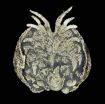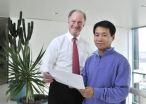(Press-News.org) Your brain's ability to instantly link what you see with what you do is down to a dedicated information 'highway', suggests new UCL-led research.
For the first time, researchers from UCL (University College London) and Cambridge University have found evidence of a specialized mechanism for spatial self-awareness that combines visual cues with body motion.
Standard visual processing is prone to distractions, as it requires us to pay attention to objects of interest and filter out others. The new study has shown that our brains have separate 'hard-wired' systems to visually track our own bodies, even if we are not paying attention to them. In fact, the newly-discovered network triggers reactions even before the conscious brain has time to process them.
The researchers discovered the new mechanism by testing 52 healthy adults in a series of three experiments. In all experiments, participants used robotic arms to control cursors on two-dimensional displays, where cursor motion was directly linked to hand movement. Their eyes were kept fixed on a mark at the centre of the screen, confirmed with eye tracking.
In the first experiment, participants controlled two separate cursors with their left and right hands, both equally close to the centre. The goal was to guide each cursor to a corresponding target at the top of the screen. Occasionally the cursor or target on one side would jump left or right, requiring participants to take corrective action. Each jump was 'cued' with a flash on one side, but this was random so did not always correspond to the side about to change.
Unsurprisingly, people reacted faster to target jumps when their attention was drawn to the 'correct' side by the cue. However, reactions to cursor jumps were fast regardless of cuing, suggesting that a separate mechanism independent of attention is responsible for tracking our own movements.
"The first experiment showed us that we react very quickly to changes relating to objects directly under our own control, even when we are not paying attention to them," explains Dr Alexandra Reichenbach of the UCL Institute of Cognitive Neuroscience, lead author of the study. "This provides strong evidence for a dedicated neural pathway linking motor control to visual information, independently of the standard visual systems that are dependent on attention."
The second experiment was similar to the first, but also introduced changes in brightness to demonstrate the attention effect on the visual perception system. In the third experiment, participants had to guide one cursor to its target in the presence of up to four dummy targets and cursors, 'distractors', alongside the real ones. In this experiment, responses to cursor jumps were less affected by distractors than responses to target jumps. Reactions to cursor jumps remained vigorous with one or two distractors, but were significantly decreased when there were four.
"These results provide further evidence of a dedicated 'visuomotor binding' mechanism that is less prone to distractions than standard visual processing,' says Dr Reichenbach. "It looks like the specialized system has a higher tolerance for distractions, but in the end it is still affected. Exactly why we evolved a separate mechanism remains to be seen, but the need to react rapidly to different visual cues about ourselves and the environment may have been enough to necessitate a specialized pathway."
The newly-discovered system could explain why some schizophrenia patients feel like their actions are controlled by someone else.
"Schizophrenia often manifests as delusion of control, and a dysfunction in the visuomotor mechanism identified in this study might be a cause for this symptom," explains Dr Reichenbach. "If someone does not automatically link corresponding visual cues with body motion, then they might have the feeling that they are not controlling their movements. We would need further research to confirm this, and it would be fascinating to see how schizophrenia patients perform in these experiments."
These findings could also explain why people with even the most advanced prosthetic limbs can have trouble coordinating movements.
"People often describe their prosthetic limbs as feeling 'other', not a true extension of their body,' says Dr Reichenbach. "Even on the best prosthetic hands, if the observed movement of the fingers is not exactly what you would expect, then it will not feel like you are in direct control. These small details might have a big effect on how people perceive prostheses."
INFORMATION:
Human brains 'hard-wired' to link what we see with what we do
Your brain's ability to instantly link what you see with what you do is down to a dedicated information 'highway', suggests new UCL-led research
2014-03-13
ELSE PRESS RELEASES FROM THIS DATE:
New view of tumors' evolution
2014-03-13
CAMBRIDGE, MA -- Cancer cells undergo extensive genetic alterations as they grow and spread through the body. Some of these mutations, known as "drivers," help spur cells to grow out of control, while others ("passengers") are merely along for the ride.
MIT cancer biologists at the Koch Institute for Integrative Cancer Research and geneticists from the Broad Institute have now performed the most comprehensive analysis to date of these changes in mice programmed to develop cancer. The team discovered mutations and other genetic disturbances that arise at certain stages ...
Parental care of the young from 450 million years ago
2014-03-13
A portrait of prehistoric parenthood captured deep in the fossil record has been uncovered by an international team of scientists led by University of Leicester geologist Professor David Siveter.
The 'nursery in the sea' has revealed a species new to science – with specimens preserved incubating their eggs together with probable hatched individuals. As a result, the team has named the new species Luprisca incuba after Lucina, goddess of childbirth, and alluding to the fact that the fossils are ancient and in each case the mother was literally sitting on her eggs.
The ...
Fossil porpoise has a chin for the ages
2014-03-13
Scientists have identified a new species of ancient porpoise with a chin length unprecedented among known mammals and suggest the animal used the tip of its face to probe the seabed for food.
Related to living crown porpoises, the extinct Californian porpoise, Semirostrum ceruttii, had an extension of its jaw called a symphysis — the analogue of the human chin — that measured 85 centimeters in the best-preserved specimen, researchers said. The typical symphysis of a crown porpoise measures one or two centimeters.
"This is unique anatomy for a mammal," said Rachel Racicot, ...
Scientists catch brain damage in the act
2014-03-13
Scientists have uncovered how inflammation and lack of oxygen conspire to cause brain damage in conditions such as stroke and Alzheimer's disease.
The discovery, published today in Neuron, brings researchers a step closer to finding potential targets to treat neurodegenerative disorders.
Chronic inflammation and hypoxia, or oxygen deficiency, are hallmarks of several brain diseases, but little was known about how they contribute to symptoms such as memory loss.
The study used state-of-the-art techniques that reveal the movements of microglia, the brain's resident ...
Forgetting is actively regulated
2014-03-13
In order to function properly, the human brain requires the ability not only to store but also to forget: Through memory loss, unnecessary information is deleted and the nervous system retains its plasticity. A disruption of this process can lead to serious mental disorders. Basel scientists have now discovered a molecular mechanism that actively regulates the process of forgetting. The renowned scientific journal "Cell" has published their results.
The human brain is build in such a way, that only necessary information is stored permanently - the rest is forgotten over ...
Research findings link post-heart attack biological events that provide cardioprotection
2014-03-13
DALLAS, March 13, 2014 – Heart attack and stroke are among the most serious threats to health. But novel research at UT Southwestern Medical Center has linked two major biological processes that occur at the onset of these traumatic events and, ultimately, can lead to protection for the heart.
On one end of the cascade is the so-called Unfolded Protein Response (UPR), and at the other end are numerous proteins with modified glucose molecules attached to them. For years, researchers have made countless observations relating to these opposite ends of the spectrum. Now, ...
'Super circles' to lessen rush-hour headaches according to Wayne State researchers
2014-03-13
DETROIT— While Mother Nature continues to challenge drivers across the country, a team of traffic engineers is working hard on a new way to make rush-hour commutes safer and faster in any weather.
"We can't do much about snow falling, but we can do something about road capacity and congestion," said Joseph Hummer, traffic engineering expert and Wayne State University College of Engineering chair of civil and environmental engineering.
Hummer and a team of traffic engineers at the Regional Transportation Alliance and North Carolina State University believe metered roundabouts, ...
You should be ashamed -- or maybe not
2014-03-13
(Santa Barbara, Calif.) — Shame on you. These three simple words can temporarily — or, when used too often, permanently — destroy an individual's sense of value and self-worth.
"In modernity, shame is the most obstructed and hidden emotion, and therefore the most destructive," said Thomas Scheff, professor emeritus of sociology at UC Santa Barbara. "Emotions are like breathing — they cause trouble only when obstructed."
When hidden, he continued, shame causes serious struggles not only for individuals but also for groups. In an article published in the current issue ...
NASA sees wind shear affecting Tropical Cyclone Lusi
2014-03-13
Tropical Cyclone Lusi is battling vertical wind shear that has been pushing the bulk of precipitation away from its center. NASA's Terra satellite captured an image of the storm that showed the strongest thunderstorms were being pushed away from the center.
On March 12 at 22:25 UTC/6:25 p.m. EDT, The Moderate Resolution Imaging Spectroradiometer or MODIS instrument that flies aboard NASA's Terra satellite captured a visible image of Tropical Cyclone Lusi in the South Pacific Ocean. The image showed a concentration of thunderstorms just south of the center of circulation.
On ...
NASA sees Tropical Cyclone Gillian's remnants hoping for comeback
2014-03-13
Ex-Tropical Cyclone Gillian weakened to a remnant low pressure area after making landfall in the Western Cape York Peninsula of Queensland, Australia then returned into the Gulf of Carpentaria. NASA's Aqua satellite flew over the tropical low as it struggled to re-intensify.
The MODIS or Moderate Resolution Imaging Spectroradiometer instrument that flies aboard NASA's Aqua satellite captured a visible image of Ex-Tropical Cyclone Gillian moving through Australia's Gulf of Carpentaria on March 13 at 4:25 UTC/12:45 a.m. EDT. Gillian appeared to have moved about two-thirds ...
LAST 30 PRESS RELEASES:
The most effective diabetes drugs don't reach enough patients yet
Breast cancer risk in younger women may be influenced by hormone therapy
Strategies for staying smoke-free after rehab
Commentary questions the potential benefit of levothyroxine treatment of mild hypothyroidism during pregnancy
Study projects over 14 million preventable deaths by 2030 if USAID defunding continues
New study reveals 33% gap in transplant access for UK’s poorest children
Dysregulated epigenetic memory in early embryos offers new clues to the inheritance of polycystic ovary syndrome (PCOS)
IVF and IUI pregnancy rates remain stable across Europe, despite an increasing uptake of single embryo transfer
It takes a village: Chimpanzee babies do better when their moms have social connections
From lab to market: how renewable polymers could transform medicine
Striking increase in obesity observed among youth between 2011 and 2023
No evidence that medications trigger microscopic colitis in older adults
NYUAD researchers find link between brain growth and mental health disorders
Aging-related inflammation is not universal across human populations, new study finds
University of Oregon to create national children’s mental health center with $11 million federal grant
Rare achievement: UTA undergrad publishes research
Fact or fiction? The ADHD info dilemma
Genetic ancestry linked to risk of severe dengue
Genomes reveal the Norwegian lemming as one of the youngest mammal species
Early birds get the burn: Monash study finds early bedtimes associated with more physical activity
Groundbreaking analysis provides day-by-day insight into prehistoric plankton’s capacity for change
Southern Ocean saltier, hotter and losing ice fast as decades-long trend unexpectedly reverses
Human fishing reshaped Caribbean reef food webs, 7000-year old exposed fossilized reefs reveal
Killer whales, kind gestures: Orcas offer food to humans in the wild
Hurricane ecology research reveals critical vulnerabilities of coastal ecosystems
Montana State geologist’s Antarctic research focuses on accumulations of rare earth elements
Groundbreaking cancer therapy clinical trial with US Department of Energy’s accelerator-produced actinium-225 set to begin this summer
Tens of thousands of heart attacks and strokes could be avoided each year if cholesterol-lowering drugs were used according to guidelines
Leading cancer and metabolic disease expert Michael Karin joins Sanford Burnham Prebys
Low-intensity brain stimulation may restore neuron health in Alzheimer's disease
[Press-News.org] Human brains 'hard-wired' to link what we see with what we doYour brain's ability to instantly link what you see with what you do is down to a dedicated information 'highway', suggests new UCL-led research





